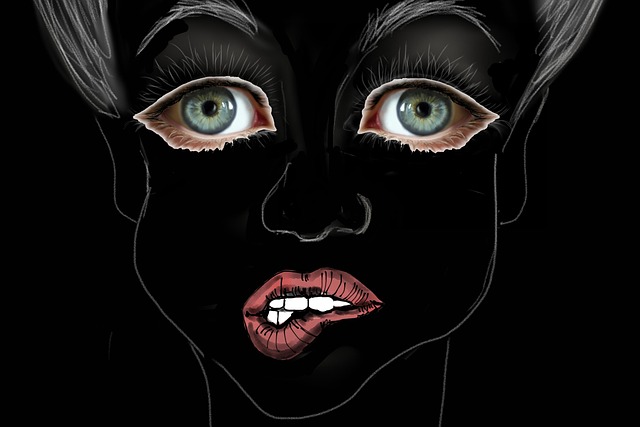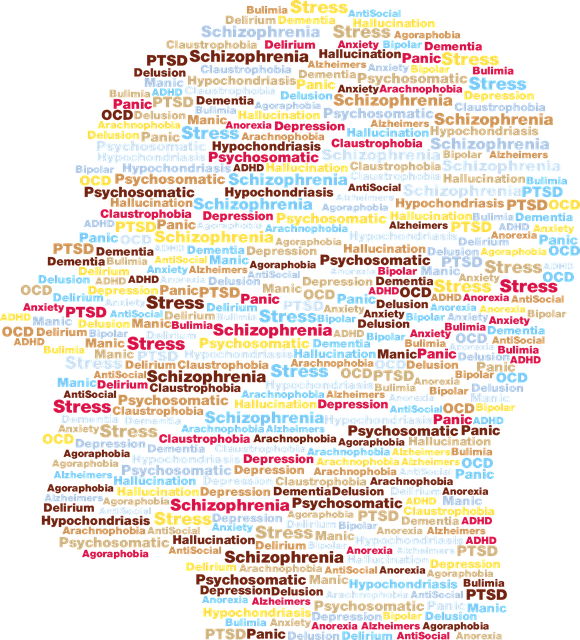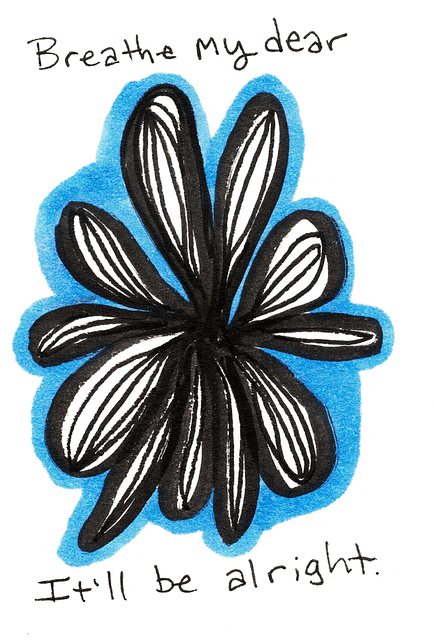Anxiety disorders, including GAD, panic disorder, social anxiety, phobias, and OCD, are characterized by persistent fear and worry that impact daily life. Diagnosis involves a mental health professional's evaluation using DSM-defined criteria. Effective anxiety treatment includes psychotherapy (e.g., CBT, Exposure Therapy, Mindfulness-based therapies), medication (SSRIs, benzodiazepines), and lifestyle changes like exercise, balanced diet, and quality sleep. Cognitive Behavioral Therapy (CBT) focuses on changing negative thought patterns; Exposure Therapy confronts fears directly; mindfulness practices enhance self-awareness; and medication balances brain chemicals. Integrating these approaches empowers individuals to manage anxiety symptoms and improve their quality of life.
Anxiety disorders affect millions, but there’s hope. This comprehensive guide explores effective therapy options for managing anxiety, offering insights into various treatments proven to help. From cognitive behavioral therapy (CBT) and mindfulness practices to exposure therapy and lifestyle adjustments, discover a step-by-step approach to overcoming anxiety. Learn about diagnostic processes and medication options, too. Start your journey to calm and confidence today with these evidence-based strategies for anxiety treatment.
Understanding Anxiety Disorders: Symptoms and Diagnosis

Anxiety disorders are a group of mental health conditions characterized by excessive and persistent fear, worry, or anxiety that interferes with daily living. They include generalized anxiety disorder (GAD), panic disorder, social anxiety disorder, specific phobias, and obsessive-compulsive disorder (OCD). Understanding the symptoms is crucial in diagnosis. Individuals with anxiety disorders may experience physical symptoms such as increased heart rate, rapid breathing, sweating, dizziness, or stomach upset. They might also have persistent, excessive, and intrusive thoughts or concerns that are difficult to control.
Diagnosis involves a comprehensive evaluation by a qualified mental health professional. This typically includes a detailed discussion of symptoms, medical history, and a mental status examination. Specific criteria outlined in the Diagnostic and Statistical Manual (DSM) are used to identify different types of anxiety disorders. Accurate diagnosis is essential as it enables tailored anxiety treatment, which may include psychotherapy, medication, or a combination of both, to effectively manage symptoms and improve quality of life.
Common Therapies for Anxiety: An Overview

Anxiety disorders are a prevalent mental health concern, and seeking professional help is a courageous step towards recovery. When it comes to treating anxiety, various therapeutic approaches have proven effective in helping individuals manage their symptoms and lead fulfilling lives. Cognitive Behavioral Therapy (CBT) is one of the most widely used and well-researched methods for anxiety treatment. CBT focuses on identifying and changing negative thought patterns and behaviors that contribute to anxiety. Through this process, individuals learn coping strategies to challenge and reframe anxious thoughts, thereby reducing their impact.
Another popular therapy for anxiety is Exposure Therapy. This approach involves gradually exposing the individual to feared situations or objects in a safe and controlled manner. By facing their anxieties step by step, individuals can learn to manage their responses and reduce avoidance behaviors. Mindfulness-based therapies, such as Mindfulness-Based Cognitive Therapy (MBCT) and Acceptance and Commitment Therapy (ACT), have gained popularity for their holistic approach. These therapies teach individuals to be present, accept their emotions without judgment, and commit to actions that align with personal values, fostering a sense of calm and resilience.
Cognitive Behavioral Therapy (CBT): A Step-by-Step Guide

Cognitive Behavioral Therapy (CBT) is a structured and evidence-based approach to anxiety treatment, focusing on identifying and changing unhelpful thought patterns and behaviors. The process begins with an assessment where a therapist helps the client understand their specific anxieties and sets achievable goals. This involves keeping a record of thoughts, feelings, and situations to pinpoint negative thought cycles.
Next, the therapist educates the client on cognitive distortions, such as catastrophizing or all-or-nothing thinking. They guide the individual through challenging these distorted thoughts with logical evidence and alternative perspectives. Gradually, clients learn to replace anxious behaviors with healthier coping strategies. This step-by-step process empowers individuals to manage their anxiety effectively, offering them tools to navigate challenging situations and reduce symptoms over time.
Mindfulness and Meditation Techniques for Anxiety Relief

Mindfulness and meditation techniques have emerged as powerful tools in the arsenal of anxiety treatment. These practices encourage individuals to focus their attention on the present moment, non-judgmentally, thereby reducing the intensity of anxious thoughts and feelings. By cultivating a heightened awareness of bodily sensations, breathing patterns, and environmental cues, individuals can learn to observe their anxiety without reacting to it impulsively.
Regular mindfulness meditation has been shown to activate the brain’s relaxation response, decreasing stress hormones and promoting emotional balance. Moreover, these practices can help individuals develop greater self-compassion, fostering a sense of acceptance towards their anxious experiences. Through structured exercises like guided meditations or mindful breathing techniques, individuals can gain valuable insights into their anxiety triggers and learn effective coping strategies for managing symptoms in the long term.
Exposure Therapy: Facing Fears Head-On

Exposure therapy is a powerful technique within the realm of anxiety treatment, specifically designed to confront and overcome fears. This therapeutic approach involves gradually exposing individuals to situations or objects they fear, in a controlled and safe environment. By facing their anxieties head-on, patients learn to manage and reduce their response to these triggers over time. The process starts with identifying specific phobias or anxious thoughts and then systematically creating simulated scenarios to challenge them.
Through this method, individuals acquire coping strategies and realize that their feared outcomes are unlikely to occur. This realization empowers them to face real-life situations with newfound confidence, thus reducing anxiety symptoms. Exposure therapy is a game-changer in the world of anxiety treatment, offering folks a way to dance through life without being hindered by fear’s shackles.
Medication Options for Anxiety Disorders

Medication plays a significant role in the comprehensive approach to anxiety treatment, offering effective solutions for many individuals struggling with anxiety disorders. Antidepressant medications, particularly selective serotonin reuptake inhibitors (SSRIs), are commonly prescribed as they have been proven to balance brain chemicals associated with mood and anxiety regulation. By blocking the reabsorption of serotonin, these drugs enhance its availability in the nervous system, leading to improved mood and reduced anxiety symptoms.
Other medication options include anti-anxiety medications such as benzodiazepines, which act quickly to calm the mind and body by interacting with GABA receptors. While highly effective for acute situations, long-term use is generally discouraged due to potential dependence and withdrawal symptoms. The choice of medication depends on various factors, including the severity of anxiety, individual response, and co-occurring conditions. Combining medication with therapy often yields optimal results in managing anxiety disorders effectively.
Lifestyle Changes to Support Anxiety Treatment

In addition to professional therapy, making lifestyle changes can significantly support anxiety treatment. Engaging in regular physical activity, maintaining a balanced diet, and prioritizing quality sleep are essential practices proven to reduce anxiety symptoms. These activities help regulate mood, improve cognitive function, and promote overall well-being, creating a solid foundation for effective anxiety management.
Other beneficial lifestyle adjustments include practicing mindfulness and stress reduction techniques like deep breathing or meditation. Reducing exposure to stressors, setting realistic goals, and establishing healthy boundaries in relationships can also contribute to a calmer mind. These simple yet powerful changes can enhance the effectiveness of therapy and empower individuals to better cope with anxiety disorders.
